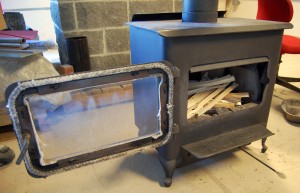Most of our wood stoves have been put to good use this winter, and mid-winter is a good time for an inspection. One of the most common causes of chimney fires is pipe contact with combustibles. After years of exposing insulation and wood framing to heat, the ignition point of the material drops and it takes less to ignite it. So checking on creosote inside the chimney and clearance to combustibles outside the chimney is time well spent.
Since people in Fairbanks primarily use factory-built insulated metal chimneys, this article provides an inspection checklist for that particular type.
Examine the chimney wherever it is accessible, especially inside the roof.
- On the outside of the pipe look for dents, missing screws or bands, rusted metal, heat discolorations, separation between sections, and any other abnormalities.
- Perform the same inspection inside the pipe, with a powerful flashlight and a mirror if necessary. The pipe should be clean and smooth, with no defects or buildup.
- Insulated metal chimneys should have an ID label and a rating. Call or visit your local building supply store to find who carries specifications for your brand of pipe. Product information is available online too.
- Pay close attention to the required clearances between the pipe and any combustible surfaces, especially inside the roof. There should be no insulation touching the pipe, even if it is rated as noncombustible, unless specifically approved by the manufacturer. Insulation installed closer than the minimum air space allowed is a serious fire hazard.
- Attic insulation shields keep the chimney pipe the proper distance from combustible materials inside the roof and are a standard off-the-shelf item. They can also be manufactured by local sheet metal shops for special applications.
- On the roof, the chimney cap should be in place to control sparks and prevent water from entering the pipe.
- The pipe should extend at least three feet above the point it exits the roof, and at least two feet above any wall, ridge, roof, or adjacent building within ten feet. If it is more than ten feet from the peak, you should be able to measure down two feet from the top of the chimney and ten feet horizontally in any direction without contacting the roof. This is considered a minimum – a greater height may be necessary for draft and safety reasons. Check with the manufacturer for specifics relating to your application.
- Make sure the chimney is protected from sliding snow, particularly on a metal roof. Snow stops, bracing, or crickets may need to be placed where impact damage can occur.
- If you are installing a new chimney, be sure to inform your insurance company, as its policies may require notification and inspection.
Chimney sweeps and wood heat installation specialists can be good resources for questions and inspections. If you are burning wood in an old untested chimney, a professional inspection and some new pipe can bring you peace of mind – instead of an emergency visit from the fire department.
